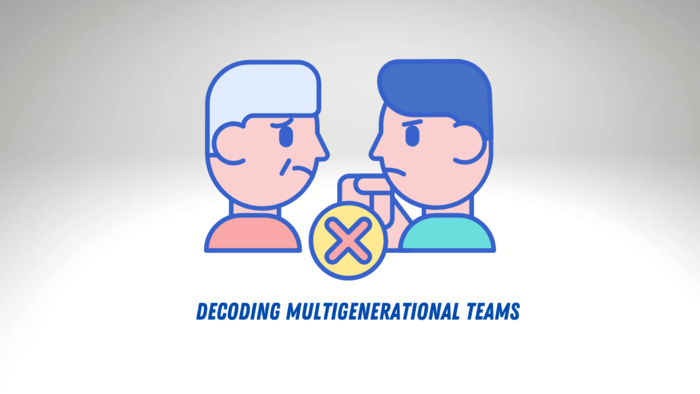How AI Tools Can Support a Demand for Data-Driven DEI
Image Description: A woman stands in the corner of a room in darkness with computer code projected over her and the wall behind her.
By Marion Davis
Within the field of diversity, equity, and inclusion (DEI), the ethical use of robust artificial intelligence tools can improve the human experience in the workplace. Ongoing criticisms of DEI have remarked on the field’s focus on feel-good initiatives rather than data-driven initiatives. Under the greater umbrella of human resources, People Operations has grown in leaps and bounds as the answer to this desire for data to guide decisions.
During the height of DEI, many large companies were focusing on reporting diversity hire numbers–even while they were rapidly losing these same newly-hired women and minority employees in layoffs. These large companies were professing a commitment to diversity, equity, and inclusion while news sources were telling the stories of women and minority employees facing immense discrimination at these same locations.
While employers were initially the entities reporting their diversity and inclusion (D&I) numbers, Glassdoor reported in January 2023 that the company had added a new section to allow all employees of an organization to report D&I numbers. More and more, the narrative on whether true diversity and inclusion is present at an organization has returned to the employees themselves. Poor Glassdoor ratings notoriously increase hiring costs and negatively impact the employer brand. Organizations quickly realized that they could report diversity numbers as much as they wanted, but the real test came down to whether all employees were happy as they now could self-report DEI feedback anonymously and publicly.
As the saying goes, happy employees make happy customers. The current shifts in DEI seem to indicate that organizations are more in the market now for developing a positive employer brand where employees are likely to report high levels of job satisfaction. Dismantling access barriers will allow diversity numbers to increase organically. From here, HR, People Operations, and DEI teams can work to anticipate employee needs and address concerns as well as create personalized support for each employee within the organization. Currently, many AI tools on the market can help streamline support offerings and even predict needs by processing large amounts of data that would be impossible to do manually. These AI tools provide professionals with the ability to improve the human experience in the workplace across intersectionality while meeting corporations’ goals of improving the employer brand in a symbiotic objective.
The following sections explore the value of the employer brand and outline various AI tools for use in the workplace toward the goal of improving employee happiness.
The Return to the Employer Brand: Old Ideas with New Methods
In recent years, old ideas have emerged with new terminology. The famous parents from the Cheaper by the Dozen books, Drs. Frank and Lilian Gilbreth were engineers who helped pioneer time-and-motion study at the turn of the 20th century. Dr. Lilian Gilbreth dedicated her work to improving women’s experiences in the workplace. This husband-and-wife duo believed that employee efficiency, happiness, wellness, and success were all intertwined in the workplace. In modern times, the Gilbreths’ work would have contributed to building what is now termed the employer brand. An employer brand is a company’s reputation for valuing its people and plays a significant role in the acquisition and retention of talent.
Using still and motion-picture cameras at a time when silent film was just beginning, the Gilbreths would observe the most efficient employees at factories, taking pictures of these employees’ movements to be replicated by other workers. The result was often that these more efficient employees had discovered innovative ways to make repetitive tasks less strenuous on their bodies and were saving the company time by completing work more efficiently. The Gilbreths were two of the first scientists to focus on ergonomic activity in the workplace with an examination of psychological and physiological principles of processes and systems in order to reduce human error and improve the well-being of employees in the workplace.
In modern times, studies have shown repeatedly that disabled employees tend to outscore non-disabled employees impressively for efficiency on the job. This can be true in warehouse settings as well as in office settings. Many disabled employees may use high levels of innovation to determine a better way to complete tasks that reduces strain on their bodies. For disabled people who have less functional time in certain areas than non-disabled people, a greater awareness of time and time management can guide a desire for greater efficiency. For instance, in an office setting, some disabled employees may push back against endless unnecessary meetings as mentally or physically exhausting and unhelpful for their completion of necessary tasks. Research on the efficacy of meetings has emerged in the business world that echoes a time-conscious mindset. One Forbes article noted that 70 percent of meetings are a waste of time and the company’s dime.
Over the past several years, some variations of DEI have been well-intentioned but produced disastrous results with a lack of hard data to back up initiatives. In 2023, employees in a global survey reported lower levels of workplace satisfaction than before, and nearly half of all executives reported that their DEI programs only paid lip service to the idea of inclusion for underrepresented groups.
People Operations is a rapidly growing field with some overlap with DEI and filling in the gaps where DEI often fails with a focus on acquiring and utilizing data to improve company culture and manage the employee experience. Perhaps DEI will rise to the need to focus more on data-driven initiatives and programs, or perhaps DEI will fade away as People Operations rises to prominence with numbers to show a return on investment.
What is clear is that much of People Operations–under the greater HR umbrella–is a return to a more scientific approach to people management in the workplace. In the early 1900s, Drs. Frank and Lilian Gilbreth recognized that data collection and analysis could guide them in improving workplace safety and efficiency that then contributed to employee happiness which is a key pillar in an organization’s success. A pioneer not just of time-and-motion study but of women’s well-being in the workplace, Dr. Lilian Gilbreth specifically set about to use her knowledge of psychology and engineering to improve workplace ergonomics in a way that would reduce access barriers for the inclusion of women in the workforce.
The Gilbreths used the tools available to them at the time to collect and utilize data to ultimately improve levels of employee happiness. In the 21st century, with many more tools available to HR, People Operations, and DEI professionals, the work world has returned full circle to a focus on employee happiness as part of the employer brand within the workplace. From this full circle movement has emerged a demand for data-driven approaches to improving workplace efficiency and safety to thus dismantle access barriers for underrepresented groups and to increase levels of employee happiness.
AI Tools to Support HR, People Operations, and DEI Teams
This section lists AI tools within function-specific subcategories and reviews the capabilities of these tools.
Candidate Sourcing
Within the talent pool, recruiters can gain a negative reputation, especially for recruiters who are simply looking to fill a spot with any warm body through both aggressive and manipulative tactics. Some examples of such tactics can include cold calling talent at their current place of work to try to headhunt them and putting their employment at risk. Other examples can include approaching disabled talent with a position that is supposedly fully remote and thus more accessible and then waiting till the call to announce that the job actually requires several visits to the office per week. These unethical actions by recruiters can create a negative talent brand for the company with which they are contracted.
A great deal of these problems with recruiters seem to stem from companies hiring agencies where members of staff are not taking the time to properly assess talent as a potential fit for the work at hand. This lack of attention to detail in a recruiter reaching out to a bilingual Chief Operating Officer to be a Spanish language tutor reflects poorly on the agency and on the company if the name is revealed.
Perhaps, the real problem is that humans are not equipped to manually analyze the online profiles and resumes of large numbers of qualified people to ascertain who might be the best fit for a job opening.
Examples of AI-Powered Candidate Sourcing Tools
Some examples of AI-powered candidate sourcing tools include:
Entelo: Entelo offers source-to-hire automation technology with predictive analytics and natural language processing (NLP). The tool predicts talents’ next career moves with reports providing information such as the statistical likelihood of people who are project managers in the SaaS industry to make a career move soon and how good a fit each person would be for the role at hand by processing millions of data points through algorithms. Entelo allows companies to create highly specific candidate-sourcing campaign goals, ranging from early-in-career targeting to veteran inclusion to diversity campaigns.
Paradox: Paradox boasts a powerful semantic search that uses machine learning to understand the skills and experience required for a role. It can then scour the web to identify qualified candidates, even those who haven't explicitly stated they're looking for a new job.
HiREz (formerly Hiretual): The HirEz platform utilizes AI to automate many outreach tasks, allowing recruiters to personalize messages at scale. HiREz can also analyze candidate responses to identify the most promising leads, saving recruiters valuable time.
Resume Screening
Job applicants have long had a contentious relationship with applicant tracking system (ATS) software. This software typically has a resume database where the tool scours potentially hundreds or thousands of resumes submitted to identify ideal candidates. Companies can then reduce the time-consuming nature of HR staff manually reviewing every resume.
The use of ATS software means that many job seekers now take steps to ensure that their resumes are ATS compliant, such as with the use of the correct format and the addition of relevant keywords from the job posting in their resumes.
A major issue here is that ATS software is not robust enough to handle the nuanced nature of human experience and views candidates more in terms of binaries of the presence or absence of certain keywords. The use of AI in resume screening allows for streamlined processing of resumes that can identify ideal candidates beyond just keywords with the AI being trained to look in depth at the larger picture of what each person brings to the table.
Some aspects that AI-powered resume scanners can offer that outshine regular ATS software include:
Semantic understanding: These scanners can analyze the context of a resume, understanding not just keywords but how the applicant describes their skills and experience.
Skills recognition: AI can automatically identify and categorize skills listed on a resume, even if they aren't listed with the exact keywords you used in the job description.
Ranking and scoring: These software options can rank candidates based on a combination of factors extracted from the resume, providing a more nuanced view than just keyword matches.
Diversity and inclusion (DEI) features: Some advanced software can identify potential biases in language used on resumes, helping ensure a fair screening process.
To promote equal access to job opportunities, companies are beginning to train their AI resume screening tools regularly on large amounts of diverse data. Legislators are enacting laws that mandate anti-bias efforts for AI tools in the hiring process. New York City has prohibited the use of artificial intelligence in resume reviews unless the technology has undergone an annual bias audit from an independent reviewer with this audit posted publicly by the employer.
Examples of AI-Powered Resume Screening Tools
Some examples of AI-powered resume screening tools include:
Ideal: This AI-powered tool goes beyond keywords, analyzing skills and experience with semantic understanding. It grades candidates (A-D) and boasts a 24/7 chatbot to automate initial interactions. Ideal integrates seamlessly with Lever for a robust screening workflow.
Freshteam: This comprehensive HR software offers powerful resume parsing with deep skills extraction. It allows for conditional screening based on specific criteria and facilitates building a strong candidate database for future hiring needs.
Lever: While Lever offers its own screening tools, it integrates with Ideal's AI for a more nuanced evaluation. Lever excels with its end-to-end recruitment functionalities, managing high-volume hiring and providing talent analytics.
Employee Education
Employee education is a crucial aspect of an employer brand. Identifying training gaps and addressing these can increase employee confidence, morale, and job satisfaction as well as increase employee retention numbers. Seventy-five percent of employees surveyed for one SHRM report stated that they were more likely to remain at a company that offers professional development opportunities.
Additionally, employee education can play a large part in succession planning. Succession planning involves the training of key members of talent at an organization to be promoted internally and assume a leadership position once this position becomes available. This approach ensures that leadership positions will not be left vacant for long due to an internal pipeline, facilitates knowledge transfer specific to the corporation from current leaders to future leaders, and demonstrates internal mobility as an option at an organization which can increase retention numbers further.
Recognizing employee education needs can be a challenge if HR, People Operations, or DEI professionals are attempting to identify training gaps or future internal promotion potential manually. Quarterly performance reviews of employees could reveal some education support needs. However, other capabilities or gaps experienced by employees could easily be inadvertently overlooked.
Thankfully, this is where AI tools truly shine with the capacity to recognize training gaps through predictive analytics, use machine learning algorithms to create personalized learning experiences for employees, set custom goals for team members, and provide learning resources to employees based on outlined learning pathways.
Examples of AI-Powered Employee Education Tools
Some examples of AI-powered resume screening tools include:
Zavvy: Zavvy is an AI-powered learning platform that identifies weaknesses in employee skill sets. The tool then creates personalized learning paths to address these gaps. By focusing on individual needs, Zavvy ensures employees are equipped for success.
Cegid: Cegid is a cloud-based learning management system (LMS) that leverages artificial intelligence. Cegid uses machine learning to personalize the learning experience for each employee. This includes recommending courses, adapting content difficulty, and providing personalized feedback.
Coassemble: Coassemble is a collaborative learning platform that uses AI to boost teamwork and knowledge sharing. It offers project-based learning where employees work together on real-world projects. Additionally, Coassemble integrates social features to encourage knowledge sharing and peer-to-peer learning.
IntelliHR: IntelliHR is an all-in-one HR platform that incorporates AI-powered employee education tools. It offers a learning management system (LMS) for creating, delivering, and tracking employee training. IntelliHR can also integrate with performance management systems to identify training needs based on employee reviews. This streamlined approach simplifies HR processes and ensures employees receive the training they need.
Degreed: Degreed is an AI-powered learning experience platform (LXP) that goes beyond traditional LMS features. It acts as a learning content curator, pulling from internal libraries, online courses, and ebooks. Degreed then personalizes learning journeys for each employee, mapping a clear path for development. These journeys often incorporate social learning features, allowing employees to share knowledge, collaborate, and track each other's progress.
Final Thoughts
The ethical use of AI tools presents a significant opportunity to enhance the human experience in the workplace, particularly when it comes to diversity, equity, and inclusion (DEI). There are currently many noted limitations of past DEI initiatives, and the corporate world has emphasized a demand for data-driven approaches. People Operations has emerged as a field that utilizes data to guide decisions and improve the employee experience. AI can play a crucial role in supporting HR, People Operations, and DEI teams by automating tasks, personalizing experiences, and identifying hidden patterns in data. The wide range of AI tools available allows these teams to focus on strategic initiatives and ensure a positive employer brand that attracts and retains top talent. As AI tools become more sophisticated, it is crucial to ensure these tools are implemented fairly and ethically. Regular bias audits and ongoing human oversight are essential to avoid unintended consequences. The future of work looks bright with AI augmenting human capabilities in the pursuit of a more equitable and fulfilling work experience for all.
Marion Davis is a contributing writer at EmployDiversityNetwork.com. She is a disabled DEIA consultant and writes on the value of diversity and inclusion across multiple industries, specifically as relates to disability and intersectionality.














